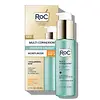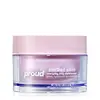What's inside
What's inside
 Key Ingredients
Key Ingredients

 Benefits
Benefits

 Concerns
Concerns

 Ingredients Side-by-side
Ingredients Side-by-side

Octocrylene 4%
UV AbsorberEthylhexyl Salicylate 4.5%
UV AbsorberHomosalate 5.5%
Skin ConditioningButyl Methoxydibenzoylmethane 2%
UV AbsorberWater
Skin ConditioningPentylene Glycol
Skin ConditioningDimethicone
EmollientOctyldodecanol
EmollientCaprylyl Methicone
Skin ConditioningPropanediol
SolventHyaluronic Acid
HumectantPotassium Cetyl Phosphate
EmulsifyingAmmonium Acryloyldimethyltaurate/Vp Copolymer
Biosaccharide Gum-4
Skin ConditioningJasminum Sambac Leaf Cell Extract
MaskingGlycerin
HumectantDibutyl Lauroyl Glutamide
Skin ConditioningCarbomer
Emulsion StabilisingAminomethyl Propanol
BufferingDibutyl Ethylhexanoyl Glutamide
Skin ConditioningCapryloyl Glycerin/Sebacic Acid Copolymer
Skin ConditioningCaprylhydroxamic Acid
1,2-Hexanediol
Skin ConditioningDisodium EDTA
Parfum
MaskingOctocrylene 4%, Ethylhexyl Salicylate 4.5%, Homosalate 5.5%, Butyl Methoxydibenzoylmethane 2%, Water, Pentylene Glycol, Dimethicone, Octyldodecanol, Caprylyl Methicone, Propanediol, Hyaluronic Acid, Potassium Cetyl Phosphate, Ammonium Acryloyldimethyltaurate/Vp Copolymer, Biosaccharide Gum-4, Jasminum Sambac Leaf Cell Extract, Glycerin, Dibutyl Lauroyl Glutamide, Carbomer, Aminomethyl Propanol, Dibutyl Ethylhexanoyl Glutamide, Capryloyl Glycerin/Sebacic Acid Copolymer, Caprylhydroxamic Acid, 1,2-Hexanediol, Disodium EDTA, Parfum
Water
Skin ConditioningGlycerin
HumectantCyclopentasiloxane
EmollientButylene Glycol
HumectantDimethicone
EmollientSodium Chloride
MaskingDimethicone Crosspolymer
Emulsion StabilisingPhenoxyethanol
PreservativePEG/PPG-18/18 Dimethicone
EmulsifyingCetyl PEG/PPG-10/1 Dimethicone
EmulsifyingChlorphenesin
AntimicrobialRosa Damascena Flower Water
MaskingParfum
MaskingPentylene Glycol
Skin ConditioningBiosaccharide Gum-1
HumectantSodium Acetylated Hyaluronate
HumectantSodium Hyaluronate
HumectantSodium Hyaluronate Crosspolymer
HumectantHydrolyzed Sodium Hyaluronate
Skin ConditioningEthylhexylglycerin
Skin ConditioningBenzyl Salicylate
PerfumingCI 14700
Cosmetic ColorantWater, Glycerin, Cyclopentasiloxane, Butylene Glycol, Dimethicone, Sodium Chloride, Dimethicone Crosspolymer, Phenoxyethanol, PEG/PPG-18/18 Dimethicone, Cetyl PEG/PPG-10/1 Dimethicone, Chlorphenesin, Rosa Damascena Flower Water, Parfum, Pentylene Glycol, Biosaccharide Gum-1, Sodium Acetylated Hyaluronate, Sodium Hyaluronate, Sodium Hyaluronate Crosspolymer, Hydrolyzed Sodium Hyaluronate, Ethylhexylglycerin, Benzyl Salicylate, CI 14700
 Reviews
Reviews

Ingredients Explained
These ingredients are found in both products.
Ingredients higher up in an ingredient list are typically present in a larger amount.
Dimethicone is a type of synthetic silicone created from natural materials such as quartz.
What it does:
Dimethicone comes in different viscosities:
Depending on the viscosity, dimethicone has different properties.
Ingredients lists don't always show which type is used, so we recommend reaching out to the brand if you have questions about the viscosity.
This ingredient is unlikely to cause irritation because it does not get absorbed into skin. However, people with silicone allergies should be careful about using this ingredient.
Note: Dimethicone may contribute to pilling. This is because it is not oil or water soluble, so pilling may occur when layered with products. When mixed with heavy oils in a formula, the outcome is also quite greasy.
Learn more about DimethiconeGlycerin is already naturally found in your skin. It helps moisturize and protect your skin.
A study from 2016 found glycerin to be more effective as a humectant than AHAs and hyaluronic acid.
As a humectant, it helps the skin stay hydrated by pulling moisture to your skin. The low molecular weight of glycerin allows it to pull moisture into the deeper layers of your skin.
Hydrated skin improves your skin barrier; Your skin barrier helps protect against irritants and bacteria.
Glycerin has also been found to have antimicrobial and antiviral properties. Due to these properties, glycerin is often used in wound and burn treatments.
In cosmetics, glycerin is usually derived from plants such as soybean or palm. However, it can also be sourced from animals, such as tallow or animal fat.
This ingredient is organic, colorless, odorless, and non-toxic.
Glycerin is the name for this ingredient in American English. British English uses Glycerol/Glycerine.
Learn more about GlycerinParfum is a catch-all term for an ingredient or more that is used to give a scent to products.
Also called "fragrance", this ingredient can be a blend of hundreds of chemicals or plant oils. This means every product with "fragrance" or "parfum" in the ingredients list is a different mixture.
For instance, Habanolide is a proprietary trade name for a specific aroma chemical. When used as a fragrance ingredient in cosmetics, most aroma chemicals fall under the broad labeling category of “FRAGRANCE” or “PARFUM” according to EU and US regulations.
The term 'parfum' or 'fragrance' is not regulated in many countries. In many cases, it is up to the brand to define this term.
For instance, many brands choose to label themselves as "fragrance-free" because they are not using synthetic fragrances. However, their products may still contain ingredients such as essential oils that are considered a fragrance by INCI standards.
One example is Calendula flower extract. Calendula is an essential oil that still imparts a scent or 'fragrance'.
Depending on the blend, the ingredients in the mixture can cause allergies and sensitivities on the skin. Some ingredients that are known EU allergens include linalool and citronellol.
Parfum can also be used to mask or cover an unpleasant scent.
The bottom line is: not all fragrances/parfum/ingredients are created equally. If you are worried about fragrances, we recommend taking a closer look at an ingredient. And of course, we always recommend speaking with a professional.
Learn more about ParfumPentylene glycol is typically used within a product to thicken it. It also adds a smooth, soft, and moisturizing feel to the product. It is naturally found in plants such as sugar beets.
The hydrophilic trait of Pentylene Glycol makes it a humectant. As a humectant, Pentylene Glycol helps draw moisture from the air to your skin. This can help keep your skin hydrated.
This property also makes Pentylene Glycol a great texture enhancer. It can also help thicken or stabilize a product.
Pentylene Glycol also acts as a mild preservative and helps to keep a product microbe-free.
Some people may experience mild eye and skin irritation from Pentylene Glycol. We always recommend speaking with a professional about using this ingredient in your routine.
Pentylene Glycol has a low molecular weight and is part of the 1,2-glycol family.
Learn more about Pentylene GlycolWater. It's the most common cosmetic ingredient of all. You'll usually see it at the top of ingredient lists, meaning that it makes up the largest part of the product.
So why is it so popular? Water most often acts as a solvent - this means that it helps dissolve other ingredients into the formulation.
You'll also recognize water as that liquid we all need to stay alive. If you see this, drink a glass of water. Stay hydrated!
Learn more about Water